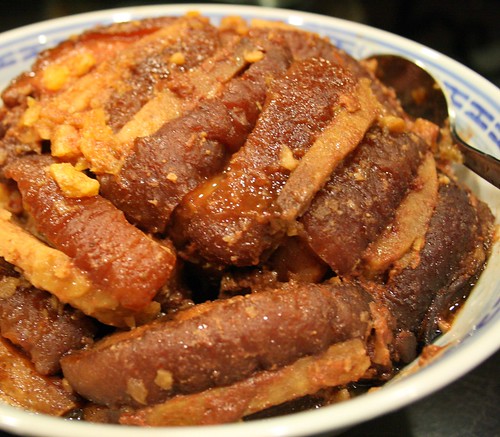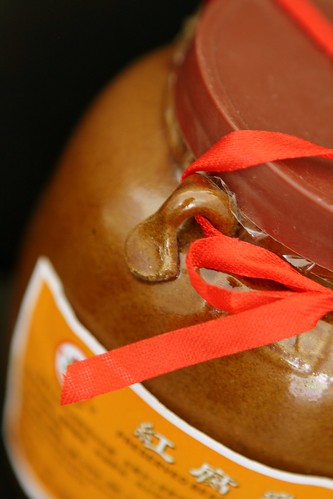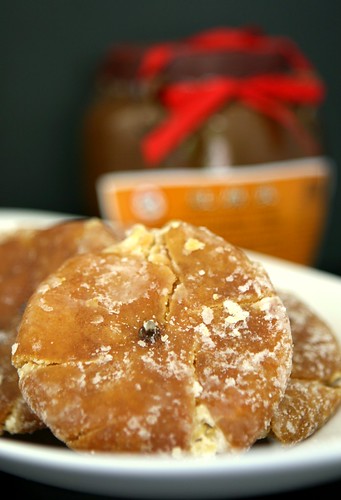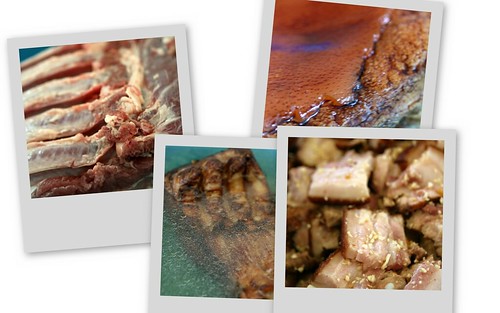 My first culinary inspiration must have come from my parents because I can still recall my father preparing the famous traditional Hakka dish called 'khew yuk' - a dish which combines pork belly slices with yam (taro).
My first culinary inspiration must have come from my parents because I can still recall my father preparing the famous traditional Hakka dish called 'khew yuk' - a dish which combines pork belly slices with yam (taro).This dish has a long and tedious process of preparation so it is only worthwhile to do a big batch at one go and share among family and friends.
That's one reason why he only made it during festive seasons.
I have watched him prepare this dish many times before but have never had the inclination to do it myself until last year...
But my dad didn't leave behind any recipes, he just went with his grey cells and taste buds, so I was at a loss as to how go about preparing this dish without him to consult.
Asked a few friends until I hit the jackpot... Mrs. Loh, a fantastic cook for traditional Hakka dishes and a good friend.
The kind soul that she is, came to the house and guided me through the whole process step by step.
Her version is very similar to my Dad's (almost identical except for the candied mandarin orange).
She came over and we did 10 bowls for this cny!
And with her consent I share with you this fantastic recipe:
Hakka's Khew yuk
Makes about 8 big chinese soup bowls
6 kg pork belly (cut into 3 long chunks, go with the grain)
4 kg yam
Oil for deep-frying
300g garlic, chopped
50g shallots, chopped
 500 gm nam yee (red fermented bean curd) - get the one packed in this small brown jug
500 gm nam yee (red fermented bean curd) - get the one packed in this small brown jug

100 gm chit pian (candied mandarin orange), minced
1 - 1 1/2 tablespoon five-spice powder
1-2 star anise, optional
1/2 cup brandy or 'mei kuei lu' (chinese rose wine)*
300g crushed rock sugar, dissolved in 1L hot water
light soy sauce
dark soy sauce

To prepare the yam:
1) Peel and cut into 4 cm x 6 cm and 1 cm thick slices.
2) Rub the pieces lightly with light soy sauce.
3) Deep fry in hot oil until golden brown. Drain and keep aside. To prepare the pork:
To prepare the pork:
1) Blanch pork in boiling water for about 5 minutes and drain.
2) Cut each piece lengthwise about 6 cm wide.
3) Rub light and dark soy sauce all over the pork.
4) Deep fry in hot oil until skin turns brown and crispy. Drain.
5) Soak the fried pork in water until the skin soften.
6) Cut into 1 cm thickness.
7) Marinate pork pieces with a tablespoon of num yee, 4-5 tablespoons minced garlic, 1 tablespoon shallots, 1/2 T 5-spice powder and 2 T chopped chit pian.
8) Save about 3-4 T each of garlic and chit pian for the final assembly of the dish (to sprinkle on the bottom of each bowl before assembling the meat and yam).
Sauce: (the most crucial stage - either make or break the dish)
1) Heat 5 T oil and fry the remaining garlic and shallots until fragrant and light golden in color.
2) Add nam yee, constantly stirring, smashing it up until it turns fragrant and the oil rises.
3) Add in the rock sugar water, chit pian, the rest of 5-spice powder and soy sauce.
Now taste - it should taste a tad more salty, sweet and intense than the final result you want because the steaming will dilute the sauce a little.
Bring to boil. Let it cool.
Add the brandy.

To assemble:
Ready 8 bowls.
~Spoon a tablespoon of the sauce into each bowl.
~Dip a piece of pork and yam into the sauce and place them in a bowl side by side with the pork skin facing downwards.
~Repeat until each bowl is filled.
~Place the leftover-odd sizes pork and yam on top of the assembled bowls to form a dome shape.
~Spoon the remaining sauce equally onto each bowl.
~Steam for 2-3 hours (depending on the age of the piggy used :p).
This dish can be made 2 to 3 weeks in advance. When cooled, wrap tightly in foil and plastic, and store in the freezer.
To serve, re-steam for 30 minutes or more. Take an empty same-size or larger bowl, place mouth-to-mouth on top of the bowl of khew yuk, hold the two bowls firmly with both hands and turn over quickly so that the khew yuk now sits in the empty bowl with the pork skin-side up.
Wanted to post this before the lunar year but just didn't manage to get the lengthy instructions done in time. I hope this post is not too late for you to try out the recipe before chap goh meh (15th day of the lunar year).
Good night.
Jo
Edit: *My brother called and corrected me that our dad used the chinese cooking wine called 'mei kuei lu' (rose wine) and not brandy.
I wasn't sure which one is a genuine good quality brand (so many imitation these days) so brandy was a safer option. Do use the rose wine if you can be sure of its quality, more authentic :D

10 comments:
My dad have been pestering for homemade khew yuk whole day yesterday. Haha..thanks for the recipe, i am sure my dad will be impressed!
You r most welcome. Let me know how it turns out. Halved the recipe and make 4 bowls. Can keep frozen for months.
gong xi gong xi!
I love this dish!! too bad I try not to have pork belly these days.. wonder if it will be ok if I use pork loin instead.. hmm.. i hv to halve that amount as well.LOL
I don't know but according to my dad the fattier the pork the better the dish - old school, i know. U can try with pork loin n let me know how it turns out...maybe next year's khew yuk can be healthier :D
Aiyoh, this dish is one of the many loves in my life! LOL! Gong Xi Fa Chai...
Forget the fattier pork, go for the happier pig instead.
Looking and reading this blogs makes me the happiest (pig) I guess :)
Gong Xi Fa Cai!!!!
wmw, mine too...love i mean and i have too many to ever get around blogging them all.
Hi, Frank, yes u r always so happy :)
I'm trying out this today, yours look the most authentic :D thank you for sharing this family secret recipe.
Very original Hakka dish indeed. Most Hakka from Kota Kinabalu can make them for Chinese New Year. You have remind me for some missing ingredients. Thank you.
This is one of the best recipe on Khew Yuk! Thank you very much. You have made it very clear for us to follow.
Post a Comment